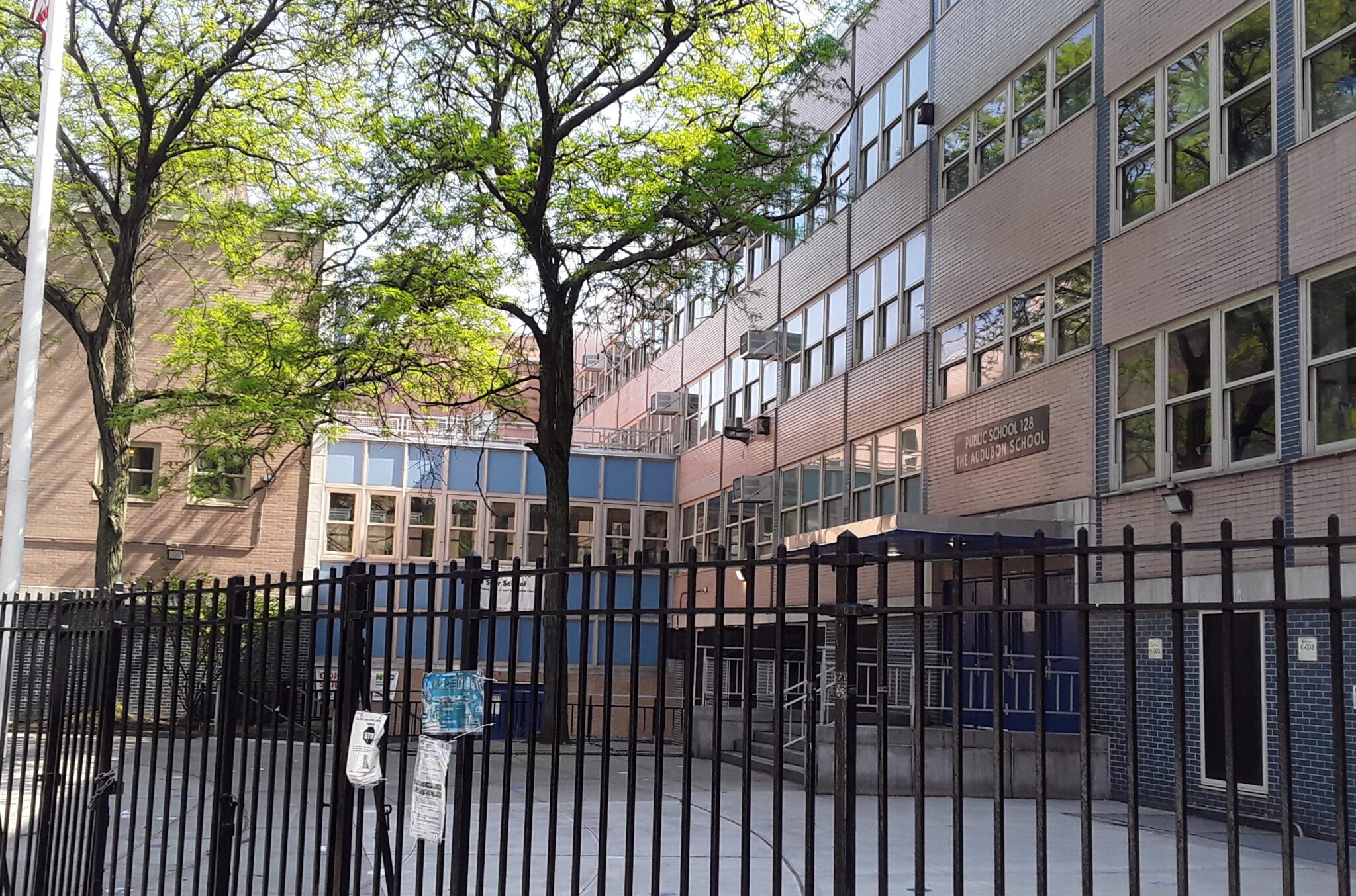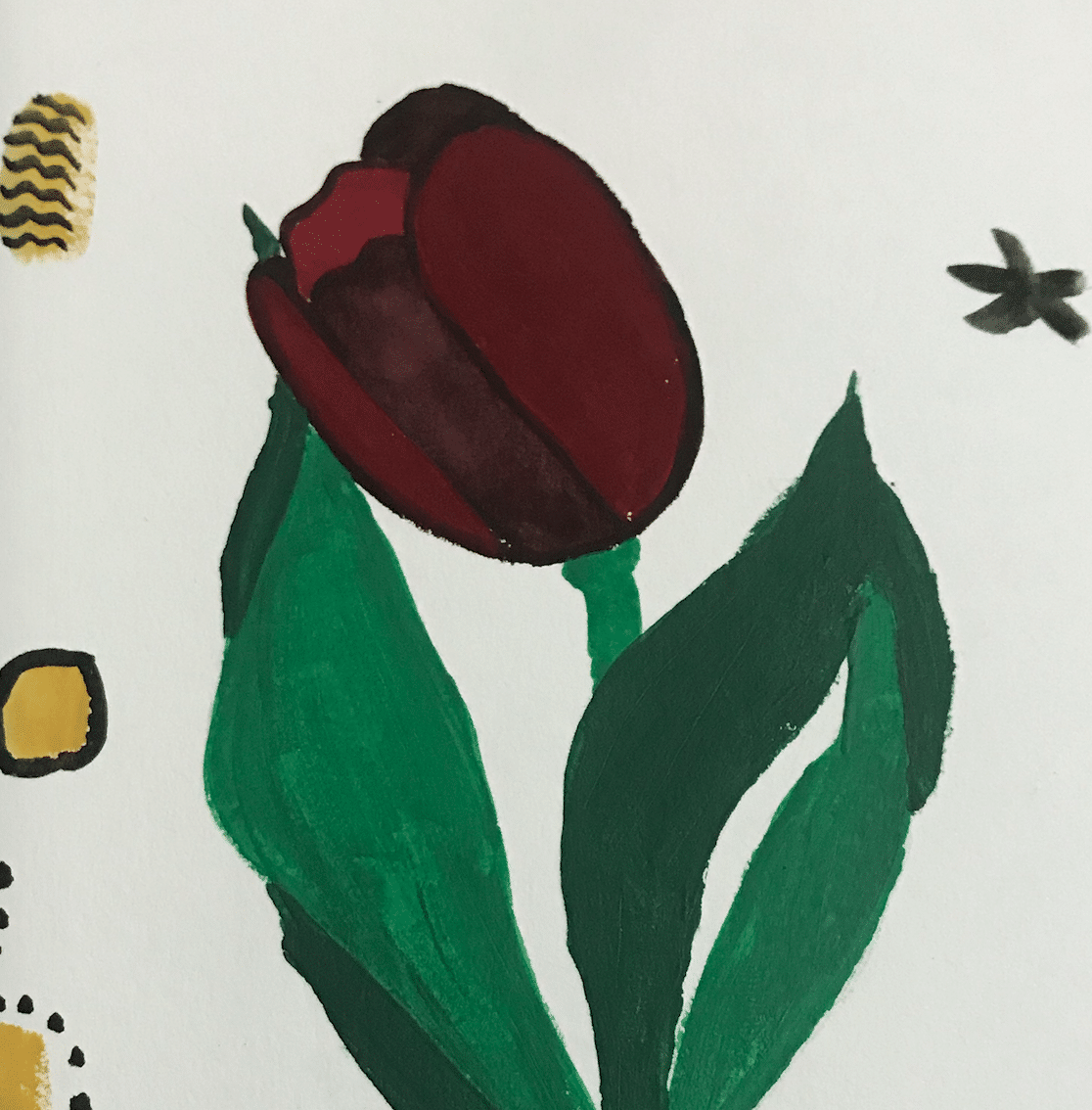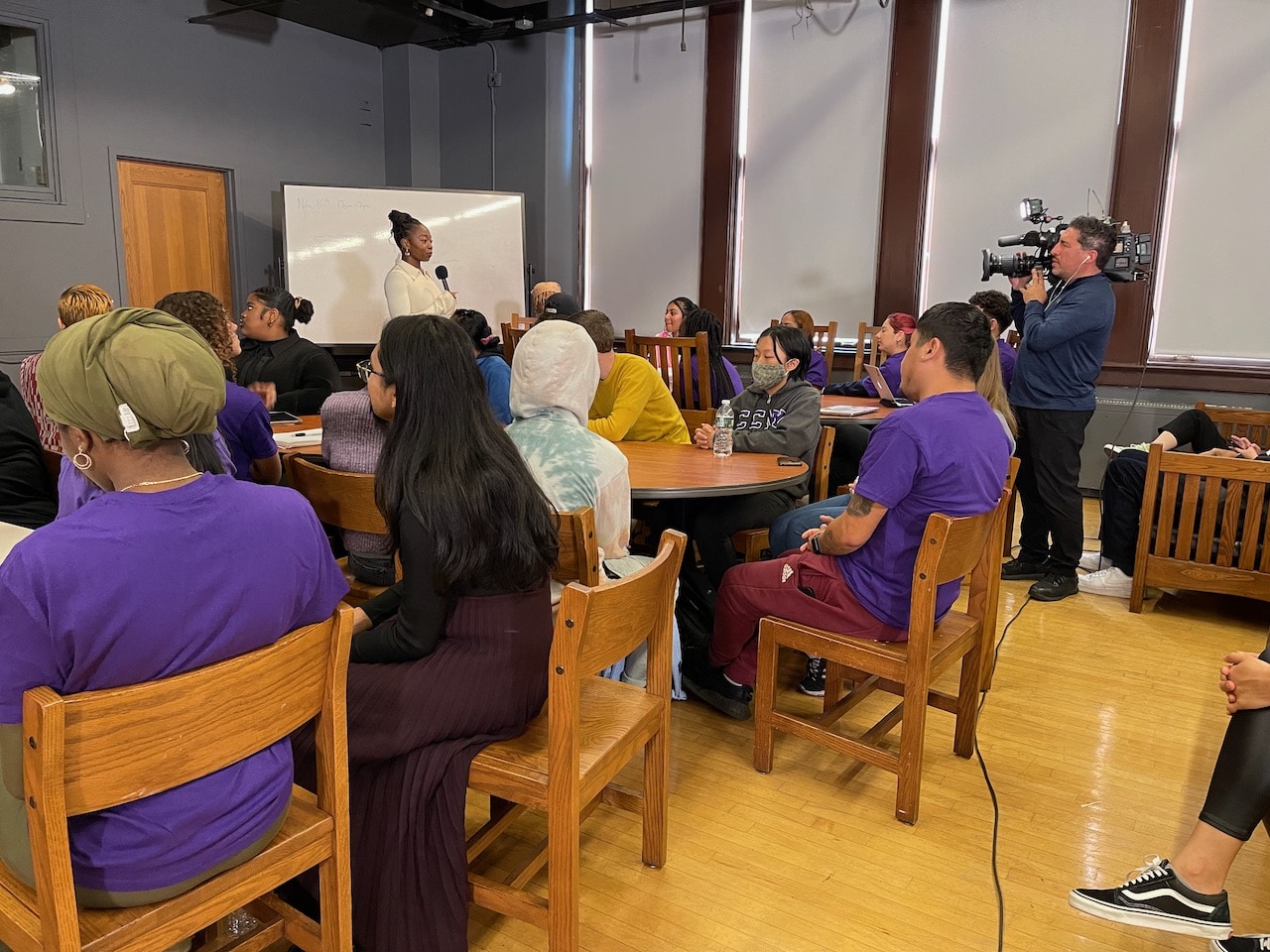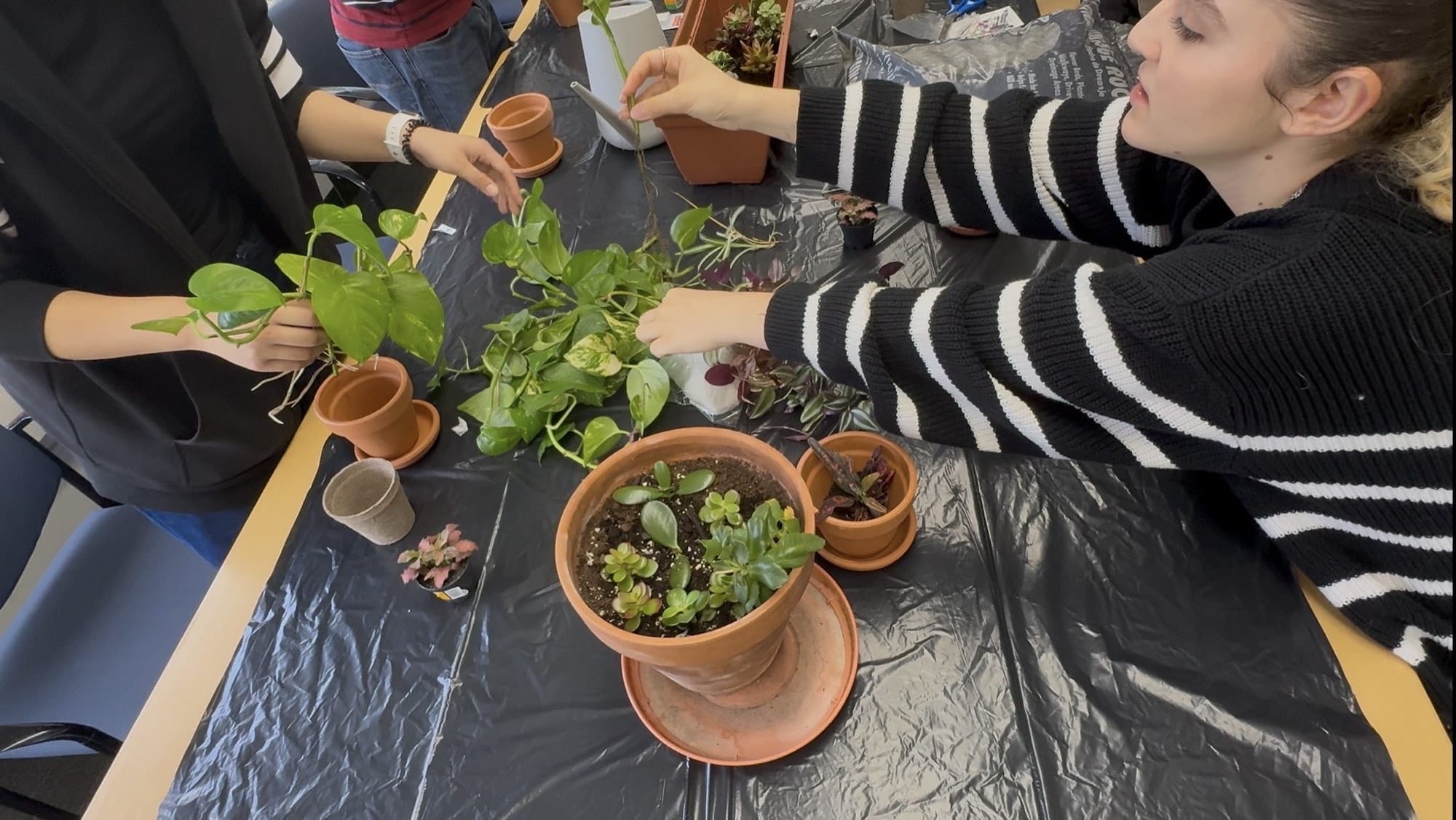Teachers and students at P.S 128, The Audubon School in Washington Heights felt happy to get back to in-person classes. Photo by Angeline Encarnacion.
This story was reported and written by a student in the Early College Program at City College Academy of the Arts (CCAA).
The vibrant sounds of students filled the classroom as they talked animatedly. They opened books and spread out their worksheets. Pencils and crayons clattered on their wooden desks. First grade teacher Ethnie Anatua sat at the front of the classroom and observed the students around her. Some students came up to her for help as she guided them on their vocabulary and math skills.
Teachers at P.S. 128 M, The Audubon School, in Washington Heights had the delight to see students in-person after almost two and a half years of online learning. Educators in different grade levels noticed the positive change in their classrooms. Students’ skills like reading and math, as well as interaction with others improved. But teachers here still face challenges.
Ms. Anatua felt relieved to be back in the classroom after enduring four months on Google Meets during the pandemic. “I was also happy because it’s easier in-person to keep control than online,” she said. Other teachers at P.S. 128 M agree. They saw students regain their ability to communicate, improve their social skills and pay more attention.
“It’s a huge difference between the time they started,” kindergarten teacher Lourdes Johnson said. When her students started school in September 2020, it was difficult for them. “Each class I have has eighteen, and only three students were reading when they came back, and now I only need three more students to learn how to read. Everybody is reading.”
Ms. Johnson has taught for 13 years, but this year in particular has felt rewarding. “So many of them are on level already, we have been working a lot in talking with the families and sending books home and having schedules for them to read every day and talking to the parents. So it’s a community, and I have seen the change and I love it,” she enthused.
During remote learning, classes were shorter. Students didn’t have most of the material that would be provided in classrooms like worksheets, crayons, or printers. They also had trouble paying attention. This posed a big problem for special education students and their teachers.
Iris Antoninette, a special education teacher for 23 years, teaches grades k 1 and 2, found that the students and their parents had trouble using Google Meets for online learning. “It was very cut and dry, a lot of parents didn’t know how to use it, or they wouldn’t log on, or there was too much noise in the background, or were distracted by their own T.V,” she said.
Now that she has the children back in the classroom, the struggle has clearly lessened. “I felt like here I had more control. It’s a very hard thing for them to catch up, but it was just easier because then I model a lot of things, so visually they need that, especially in a special ed class.”
She also found that students seemed more emotionally connected to each other because of the pandemic experience. “And they’re pretty good to each other. They’re not fighting, they’re not criticizing each other. From what I’ve seen in general because I also teach Saturday Academy with the upper grades, they were very respectful to each other.”
Ms. Johnson similarly said, “In the classroom we have all the control. The parents are not there so the kids can grow more.” She adds, “Other grades, maybe sixth grade would be okay but kindergarten was really difficult because of their attention span.”
Social distancing and masks proved to be difficult for students and teachers. Children with special needs in speech and language impairment have an especially hard time. For teachers like Ms. Antoinette, it was still an improvement from online learning.
“The biggest struggle was keeping the mask on. Even for these kids, how do you tell a kid that they have to keep their mask on? I could keep the mask on so I felt sorry for the kids because I couldn’t understand, and in a special ed class, a lot of the kids have speech and language impairment, so I couldn’t understand.”
Because of online learning, many teachers have struggled to find out where students are in terms of basic skills.
“Now it’s them catching up, trying to catch up. And trying to get them back into a routine, where you have to work with numbers, where you have to read a book every day, you have to use a pencil, so that’s a struggle,” said Ms. Antoinette.
But it’s not just with special needs students, kindergarten teachers as well have also faced this problem. Ms. Johnson said it took students a bit to adjust. “They were looking at me like, waiting for me to tell them what to say. All the time, looking at me. When I ask a question, they wait for me to tell them so that they can repeat. So that made it really difficult.” Students she thinks didn’t have a lot of confidence in themselves. “That took two or three months for them to get used to how does a reader do, to look at the paper, to put their finger, to go through the words. So that was really something we really had to do a lot when they came back.”
The teachers have made a big effort to create a normal environment for students and it seems to have worked. “{There was} relief of coming back, a little space of safety,” said Ms. Anatua.
Parents as well have settled into readjusted schedules of bringing their children back to school. “I think the parents also are really happy. Many of them are like ‘oh my god, it’s a huge difference,” she said.
Students in the English as a Second Language program (ESL) also benefited from the return to school. Ms. Johnson, the kindergarten teacher, sees the difference.
“Kindergarteners, they usually are from a Spanish community, many of them only bring two, knows two or three letters maybe, I had four that knew 20 letters, sounds, but now it’s April and they already know how to read.”
You can see the difference in the students in the classrooms. In-person gives them the chance to dance to math music videos and pay close attention to math lessons. They seem more eager to participate and ask each other questions about how to spell and read words with their books.
Some of the children I spoke with also felt that coming back had become easier for them.
“I think online class is boring, I like being in school more,” said Marie, age seven.
Mia, age six, also seemed to agree. “I like being with my friends,” she said.
NYC protocols relaxed and masks have become optional for students and there are shorter quarantine periods. The up and down COVID infection rate continues to be a challenge for teachers, but it hasn’t slowed them down at P.S 128 M.
“I think that was the best thing that they did, coming back, and I make it fun, I think. I’m glad they came back,” said Ms. Antoinette.
Tags: Angeline Encarnacion City College Journalism Early College Program City College Ethnie Anatua Google Meets Iris Antoinette Lourdes Johnson P.S. 128 M The Audubon School The City College Academy of the Arts (CCAA)
Series: High School Journalists






